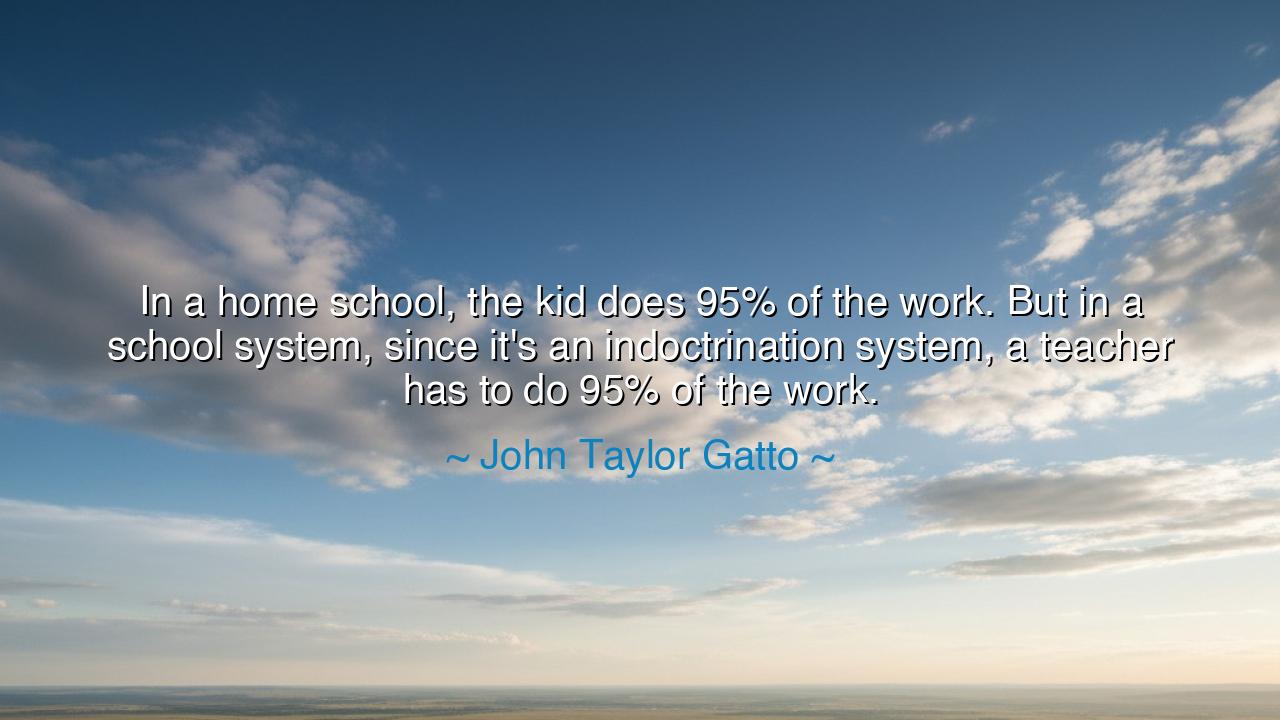
In a home school, the kid does 95% of the work. But in a school
In a home school, the kid does 95% of the work. But in a school system, since it's an indoctrination system, a teacher has to do 95% of the work.






The educator and philosopher John Taylor Gatto once declared, “In a home school, the kid does 95% of the work. But in a school system, since it's an indoctrination system, a teacher has to do 95% of the work.”
In these words lies a sharp and unsettling truth about education — the difference between the awakening of the mind and the conditioning of obedience. Gatto, who spent decades as a public school teacher before turning reformer, spoke not to condemn teachers but to expose the system that shackles both teacher and student alike. His words echo like the warning of an ancient sage: that the purpose of true learning is freedom, while the purpose of indoctrination is control. The contrast he draws between home learning and institutional schooling is not merely about place, but about the spirit of learning itself.
In the home school, Gatto says, the child carries the weight of discovery. There, curiosity is the compass, and learning springs from the inside out. The child seeks, questions, fails, and rises again — forging knowledge through effort, not coercion. The teacher, whether parent or mentor, stands not as master but as guide, offering light but never leading by the hand. This is the education of the ancients, the way of Socrates and Confucius, of mentors who drew forth wisdom from within the pupil rather than pouring it from without. In such a setting, the student becomes the craftsman of their own intellect, shaping their mind as an artist shapes clay, with patience and self-direction.
But in the school system, Gatto saw a different truth — one that troubled his soul. He called it an indoctrination system, a machine that requires teachers to do nearly all the work, not in nurturing thought, but in enforcing uniformity. There, the child becomes a vessel, and the teacher the one who fills it. The classroom becomes a factory of answers, not questions. The rhythm of bells replaces the rhythm of curiosity; the syllabus replaces wonder; the test replaces truth. The teacher, bound by bureaucracy, must labor tirelessly to maintain order, to ensure compliance, to mold minds into shapes deemed acceptable by the system. The result is a generation that can recite but not reason, conform but not create.
This struggle is not new. The ancient philosophers warned of it long ago. Plato, in his allegory of the cave, described the human condition as one of imprisonment by shadows — people taught not to see, but to accept what is shown to them. Only the one who breaks free and turns toward the light discovers truth for himself. In the same way, Gatto reminds us that education must be an act of liberation, not domestication. The indoctrinated student remains in the cave, repeating the shadows of others; the self-taught student dares to walk into the sunlight of understanding.
Consider the example of Leonardo da Vinci, who was never schooled in the rigid manner of institutions, but taught himself through observation, experiment, and relentless curiosity. He studied the flight of birds, the anatomy of the human body, the play of light upon water. His teachers were the natural world and his own hunger for knowledge. Such a mind, unfettered by conformity, could not have flourished in a place where questions were discouraged. Gatto’s words remind us that greatness grows not from instruction, but from inspiration — from the sacred fire of curiosity that burns in every human heart when it is not extinguished by authority.
In calling formal schooling an “indoctrination system,” Gatto does not accuse every teacher of malice, but he warns of a structure that rewards obedience over originality. The tragedy of modern education, he implies, is that it trains children to seek permission for their own thoughts. The teacher, burdened by the system’s demands, becomes a prisoner as well — forced to carry the student’s mind instead of allowing the student to carry it themselves. In such a world, learning becomes performance, not transformation.
So, my child of the mind, take this lesson deeply to heart: learning is your own sacred labor. Do not wait to be taught what you can discover. Do not mistake education for the memorization of facts or the praise of authority. True learning is a fire kindled within, not a script recited without. Whether you walk in schools, or fields, or through the corridors of solitude, seek to be the one who “does 95% of the work” — who questions, creates, and claims wisdom as your own.
For Gatto’s wisdom is this: freedom of thought is the highest education. It cannot be granted by institutions, nor measured by grades. It must be won, as all freedom must be — through effort, through struggle, through the unrelenting courage to think for yourself. When you learn this, you will have left behind indoctrination and entered into wisdom. Then, like the true seekers of every age, you will know what it means to be both student and teacher of your own soul.






AAdministratorAdministrator
Welcome, honored guests. Please leave a comment, we will respond soon